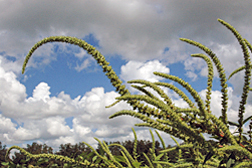This page has been archived and is being provided for reference purposes only. The page is no longer being updated, and therefore, links on the page may be invalid.
| Read the magazine story to find out more. |
|
|
 ARS plant pathologist Doug Boyette has found a fungus that can be grown in a fermentor which may be able to control Palmer amaranth, a weed that is becoming resistant to some herbicides. Click the image for more information about it. |
|
|
Fungus May Offer Natural Weed Control
By Jan SuszkiwNovember 18, 2013
A naturally occurring fungus may prove useful in the fight against Palmer amaranth, an aggressive southern weed that can grow at the rate of two inches a day and outcompete corn, cotton, soybean and other crops for resources, potentially reducing their yields.
To make matters worse, some biotypes of the weed have become resistant to glyphostate herbicides. As a possible alternative, U.S. Department of Agriculture (USDA) scientists in Stoneville, Miss., are exploring ways to formulate Myrothecium verrucaria, a fungus which attacks Palmer amaranth's leaf and stem tissues, causing wilt, necrotic lesions, loss of chlorophyll, and other disease symptoms that can kill young plants and weaken older ones.
Studies by Robert Hoagland, Doug Boyette and others at the Jamie Whitten Delta States Research Center operated by USDA's Agricultural Research Service (ARS) in Stoneville, indicate Myrothecium can wreak similar havoc on biotypes of Palmer amaranth that resist glyphosate and other herbicides such as triazines.
To test Myrothecium's infectivity, the researchers used a filamentous growth stage known as mycelium and sprayed a special formulation of it onto two batches of four-week-old Palmer amaranth seedlings: those with glyphosate resistance and those without. They repeated the same procedure with six-week-old plants. All groups were visually checked for symptoms over the experiment's seven-day (168-hour) period and then weighed for reductions in shoot growth.
Seedlings were most susceptible, with all plants exposed to a full-strength application of the fungus showing disease symptoms. By 48 to 72 hours, nearly 100 percent had died. In six-week-old plants, symptoms progressed more slowly, but there was no significant difference in injury between glyphosate-resistant and glyphosate-susceptible plants. Both groups showed disease symptoms, most notably chlorosis, some necrosis, and stunted growth.
The findings, published in Allelopathy Journal, mark the first report of Myrothecium's bioherbicidal activity against a weed species with glyphosate resistance.
Read more about this research in the November/December 2013 issue of Agricultural Research magazine. ARS is USDA's principal intramural scientific research agency.

